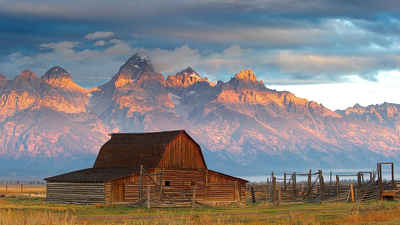Wyoming Economy
Agriculture and Industry Services and Products
Wyoming economy is a set of human and social activities and institutions related to the production, distribution, exchange and consumption of agriculture and industry goods and services. The balance between Wyoming various economic sectors differs largely between various regions and other states in the US.Wyoming Agriculture and Industry
Wyoming's real gross state product in 2012 was estimated to be $31,302 which was $156,138 and 83% lower than the national state average, $187,440. Wyoming has the 50th highest GSP out of the 50 states.
Wyoming's towering mountains and vast plains provide spectacular scenery, grazing lands for sheep and cattle, and rich mineral deposits.
Mining is the state's most important industry, and Wyoming lands are estimated to contain 1.4 trillion tons of coal, the largest coal resources in the US The world's largest surface coal mine complex is located near Gillette. In addition, Wyoming leads the nation in the production of bentonite and trona. It is second in the nation in its uranium deposits. Wyoming also contains a wealth of gemstones including jade, moss agate, rubies, jasper, bloodstones, diamonds, and peridot.
Although mining produces a larger amount of the state's income, the majority of the state's residents make their living in farming or ranching. In 2000, Wyoming ranked second in the US in wool production, and third in sheep and lambs. The state also has more than 1.5 million cattle. Large grazing lands are required because the grass is sparse in Wyoming, and the average ranch in the state is larger than in any other state except Arizona. Crops grown in the state include wheat, oats, sugar beets, corn, barley and alfalfa.
Wyoming's other natural resources make it a great tourist destination. There are 15,846 miles of fishing streams and 297,633 acres of fishing lakes supporting 31 species of game fish. Big game hunters come to the state for its elk, deer, moose, antelope, bighorn sheep, mountain goats, black bear, grizzly bear and mountain lions. There are also a large number of rodeos, roundups and frontier celebrations along with numerous "dude" ranches that draw vacationers in great numbers.
In 2001, Wyoming's gross state product gross state product was $20.4 billion, the 3rd-smallest among the states, to which government contributed $2.8 billion; transportation and public utilities, $2.6 billion; general services, $2.4 billion; financial services, $2.35 billion; trade, $2.3 billion; manufacturing, $1.5 billion; and construction, $1.1 billion. The public sector in 2001 constituted 13.7% of gross state product, above the 12% average for the states.
Wyoming Agriculture:
Cattle, sugar beets, sheep, hay, wheat.
Wyoming Industry:
Mining, chemical products, lumber and wood products, printing and publishing, machinery, tourism.
The economic life of Wyoming is largely sustained by agriculture- chiefly feed grains and livestock- and mining, including petroleum and gas production.
Mining and petroleum production mushroomed during the 1970s, leading to a powerful upsurge in population. In the early 1980s, unemployment remained
low, per capita income was high, and the inflation rate declined. The absence of personal and corporate income taxes helped foster a favorable business
climate during the 1990s. The state economy's annual growth rate accelerated coming into the 21st century, from 1.1% in 1998 to 3.6% in 1999 to 12.3%
in 2000. Not heavily involved in the information technology (IT) boom of the 1990s, Wyoming was relatively unaffected by its bust in 2001, registering
annual growth of 6.8% for the year. The main growth sectors have been various categories of services, with output from general services up 37.9% 1997
to 2001; from trade, up 29.1%; from the government sector, up 24.3%, and from financial services, up 23.6%.

US economy is relies on private decision-making ("economic freedom")




